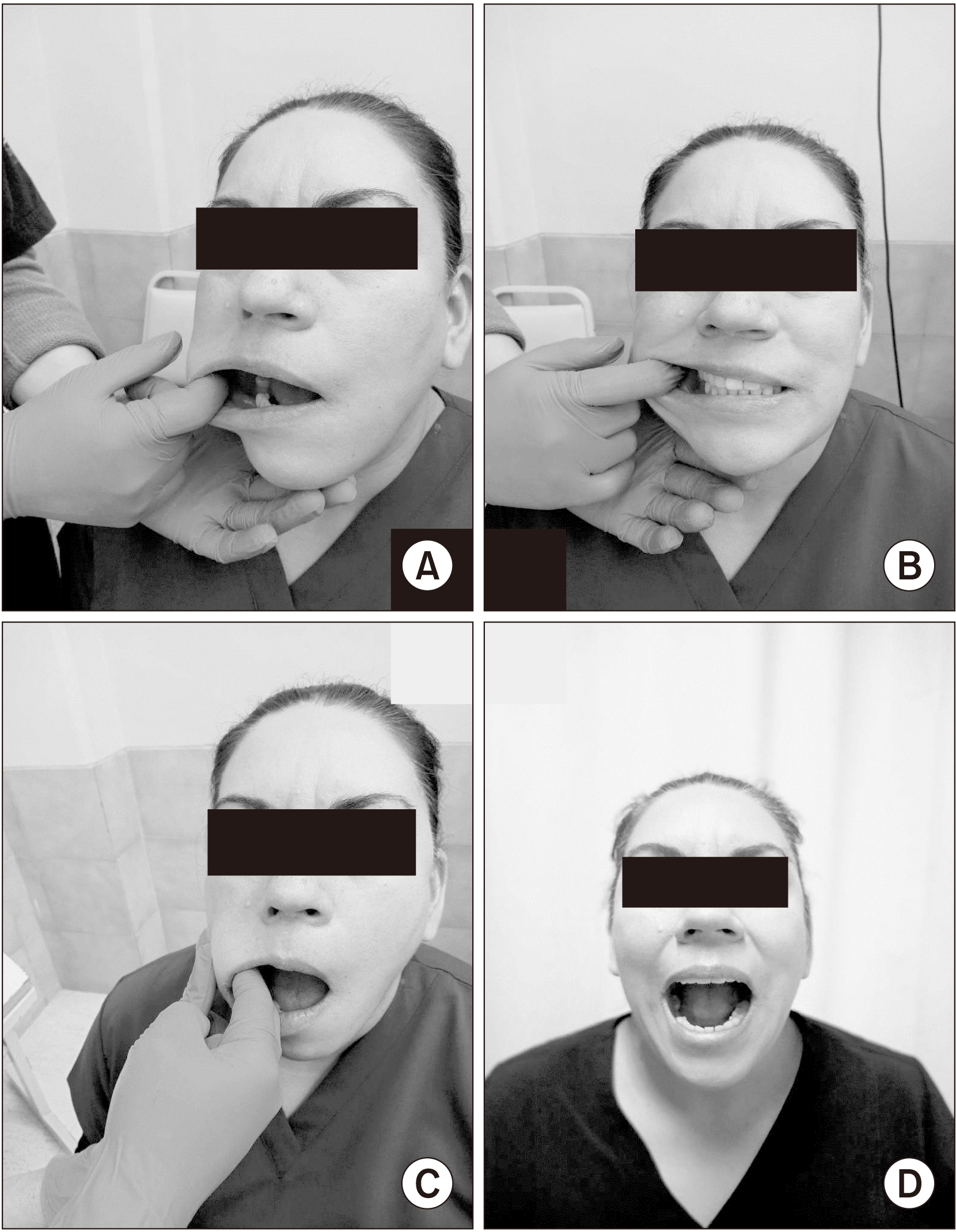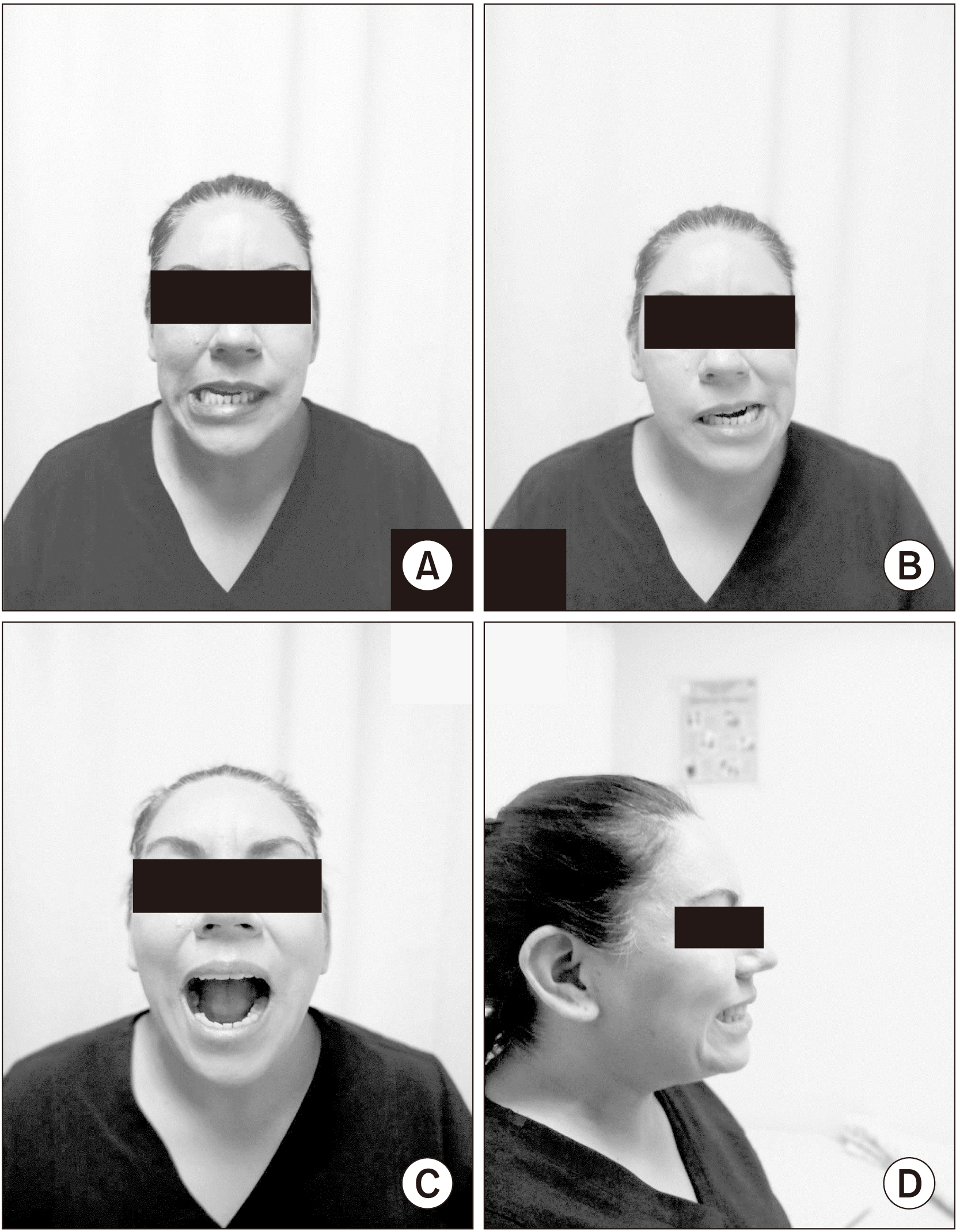J Korean Assoc Oral Maxillofac Surg.
2022 Feb;48(1):50-58. 10.5125/jkaoms.2022.48.1.50.
A home-based exercise program for temporomandibular joint osteoarthritis: pain, functionality, and joint structure
- KMID: 2526810
- DOI: http://doi.org/10.5125/jkaoms.2022.48.1.50
Abstract
Objectives
Osteoarthritis (OA) is the most prevalent and disabling joint disease in the world. Temporomandibular joint (TMJ) exercise is a widely used treatment and could be a beneficial and long-term tool for treating TMJ OA. The present study aims to evaluate the effects of therapeutic exercise in the conservative treatment of TMJ OA.
Materials and Methods
A single-group experimental pre-post test was performed. We included patients who met the diagnostic criteria for TMJ OA. Outcome variables were pain intensity (visual analogue scale), functionality (Helkimo index), and structural changes (ultrasound). Follow-up periods were at months 1, 3, and 6. The intervention included a home-based program with thermotherapy, manual therapy, and therapeutic exercise during the entire follow-up period.
Results
We included 15 patients and 26 joints, all women with a median age of 57 years (range, 49-62 years). Median change in pain intensity on joint palpation, mouth opening, and at rest at the first month was 47.5 mm, 51 mm, and 60 mm, respectively, and 48 mm, 49.5 mm, and 42.5 mm, at six months (P=0.001). The Helkimo index showed significant improvement in medians from baseline severe dysfunction (17 points) to minimal dysfunction at three and six months (2 points) (P=0.001). Ultrasound showed improved disc position.
Conclusion
This study demonstrated significant improvements in pain, function, and joint disc position and represents a valuable tool for the longterm treatment of patients with TMJ OA.
Keyword
Figure
Reference
-
References
1. Sharma L. 2021; Osteoarthritis of the knee. N Engl J Med. 384:51–9. https://doi.org/10.1056/NEJMcp1903768. DOI: 10.1056/NEJMcp1903768. PMID: 33406330.
Article2. Kalladka M, Quek S, Heir G, Eliav E, Mupparapu M, Viswanath A. 2014; Temporomandibular joint osteoarthritis: diagnosis and long-term conservative management: a topic review. J Indian Prosthodont Soc. 14:6–15. https://doi.org/10.1007/s13191-013-0321-3. DOI: 10.1007/s13191-013-0321-3. PMID: 24604992. PMCID: PMC3935038.
Article3. Liu Y, Wu J, Fei W, Cen X, Xiong Y, Wang S, et al. 2018; Is there a difference in intra-articular injections of corticosteroids, hyaluronate, or placebo for temporomandibular osteoarthritis? J Oral Maxillofac Surg. 76:504–14. https://doi.org/10.1016/j.joms.2017.10.028. DOI: 10.1016/j.joms.2017.10.028. PMID: 29182905.
Article4. Whyte A, Boeddinghaus R, Bartley A, Vijeyaendra R. 2021; Imaging of the temporomandibular joint. Clin Radiol. 76:76.e21–35. https://doi.org/10.1016/j.crad.2020.06.020. DOI: 10.1016/j.crad.2020.06.020. PMID: 32709388.
Article5. Rani S, Pawah S, Gola S, Bakshi M. 2017; Analysis of Helkimo index for temporomandibular disorder diagnosis in the dental students of Faridabad city: a cross-sectional study. J Indian Prosthodont Soc. 17:48–52. https://doi.org/10.4103/0972-4052.194941. DOI: 10.4103/0972-4052.194941. PMID: 28216845. PMCID: PMC5308067.
Article6. Iagnocco A, Naredo E. 2017; Ultrasound of the osteoarthritic joint. Clin Exp Rheumatol. 35:527–34. PMID: 28229810.7. Al-Ani Z. 2021; Temporomandibular joint osteoarthrosis: a review of clinical aspects and management. Prim Dent J. 10:132–40. https://doi.org/10.1177/2050168420980977. DOI: 10.1177/2050168420980977. PMID: 33722124.
Article8. Derwich M, Mitus-Kenig M, Pawlowska E. 2020; Interdisciplinary approach to the temporomandibular joint osteoarthritis-review of the literature. Medicina (Kaunas). 56:225. https://doi.org/10.3390/medicina56050225. DOI: 10.3390/medicina56050225. PMID: 32397412. PMCID: PMC7279162.
Article9. Wright EF, Klasser GD. 2019. Manual of temporomandibular disorders. 4th ed. Wiley-Blackwell;Hoboken (NJ): DOI: 10.25241/stomaeduj.2020.7(2).bookreview.4.10. Schiffman E, Ohrbach R, Truelove E, Look J, Anderson G, Goulet JP, et al. 2014; ; International RDC/TMD Consortium Network, International Association for Dental Research; Orofacial Pain Special Interest Group, International Association for the Study of Pain. Diagnostic criteria for temporomandibular disorders (DC/TMD) for clinical and research applications: recommendations of the International RDC/TMD Consortium Network* and Orofacial Pain Special Interest Group†. J Oral Facial Pain Headache. 28:6–27. https://doi.org/10.11607/jop.1151. DOI: 10.11607/jop.1151. PMID: 24482784. PMCID: PMC4478082.
Article11. Mejersjö C, Wenneberg B. 2008; Diclofenac sodium and occlusal splint therapy in TMJ osteoarthritis: a randomized controlled trial. J Oral Rehabil. 35:729–38. https://doi.org/10.1111/j.1365-2842.2008.01863.x. DOI: 10.1111/j.1365-2842.2008.01863.x. PMID: 18482350.
Article12. Tuncer AB, Ergun N, Tuncer AH, Karahan S. 2013; Effectiveness of manual therapy and home physical therapy in patients with temporomandibular disorders: a randomized controlled trial. J Bodyw Mov Ther. 17:302–8. https://doi.org/10.1016/j.jbmt.2012.10.006. DOI: 10.1016/j.jbmt.2012.10.006. PMID: 23768273.
Article13. Shimada A, Ishigaki S, Matsuka Y, Komiyama O, Torisu T, Oono Y, et al. 2019; Effects of exercise therapy on painful temporomandibular disorders. J Oral Rehabil. 46:475–81. https://doi.org/10.1111/joor.12770. DOI: 10.1111/joor.12770. PMID: 30664815.
Article14. McNeely ML, Armijo Olivo S, Magee DJ. 2006; A systematic review of the effectiveness of physical therapy interventions for temporomandibular disorders. Phys Ther. 86:710–25. DOI: 10.1093/ptj/86.5.710. PMID: 16649894.
Article15. de Souza RF, Lovato da Silva CH, Nasser M, Fedorowicz Z, Al-Muharraqi MA. 2012; Interventions for the management of temporomandibular joint osteoarthritis. Cochrane Database Syst Rev. 2012:CD007261. https://doi.org/10.1002/14651858.CD007261.pub2. DOI: 10.1002/14651858.CD007261.pub2. PMID: 22513948. PMCID: PMC6513203.
Article16. Calixtre LB, Grüninger BL, Haik MN, Alburquerque-Sendín F, Oliveira AB. 2016; Effects of cervical mobilization and exercise on pain, movement and function in subjects with temporomandibular disorders: a single group pre-post test. J Appl Oral Sci. 24:188–97. https://doi.org/10.1590/1678-775720150240. DOI: 10.1590/1678-775720150240. PMID: 27383698. PMCID: PMC5022215.
Article17. Razek AA, Al Mahdy Al Belasy F, Ahmed WM, Haggag MA. 2014; Assessment of articular disc displacement of temporomandibular joint with ultrasound. J Ultrasound. 18:159–63. https://doi.org/10.1007/s40477-014-0133-2. DOI: 10.1007/s40477-014-0133-2. PMID: 26191103. PMCID: PMC4504863.
Article
- Full Text Links
- Actions
-
Cited
- CITED
-
- Close
- Share
- Similar articles
-
- A Large Subchondral Cyst in an Osteoarthritic Temporomandibular Joint: A Case Report
- A Study on Effects of Tai-Chi Exercise Program on Joint Flexibility for Osteoarthritis Patients
- The Association between Temporomandibular Joint Disorders and Lumbar Diseases in Adults
- Magnetic resonance evidence of joint effusion in patients with temporomandibular joint disorders
- A study on simultation of the mandibular movement of the patients with temporomandibular joint disorder






